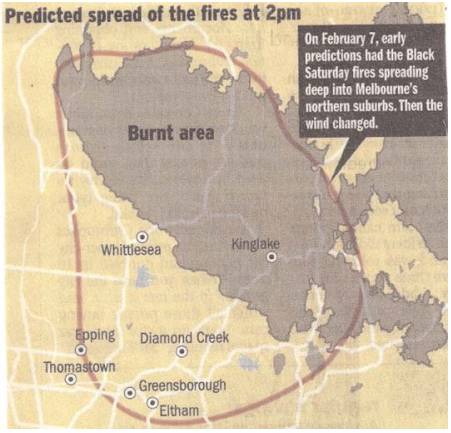Far too much media commentary on the recent Australian bushfire crisis lacks scientific rigor. Much of it ignores the physics of fuel loads, measured in tonnes per hectare; and fire intensity, measured in megawatts per metre of fire front. Numerous bushfire experts and frontline firefighters have confirmed to the Australian Alert Service that climate change is irrelevant and only by reducing fuel loads will we prevent needless loss of life and property. Governments’ criminal negligence in allowing the build-up of fuel loads, despite numerous warnings from fire experts, may result in criminal prosecutions among our corrupt political class for involuntary manslaughter through negligence.
The nationwide death toll for this season’s bushfires is currently at 28. Fortunately, it’s much lower than the 173 fatalities of Black Saturday in 2009 or the 75 fatalities of Ash Wednesday in 1983. But the danger is far from over. Should winds fan raging bushfires into the outer suburbs of our capital cities, the death toll this season or in the immediate years ahead may be in the thousands, with hundreds of thousands traumatised.
Were it not for a favourable wind change in February 2009, the Black Saturday bushfires would have penetrated deep into Melbourne’s suburbs, incinerating homes in Diamond Creek, Eltham and Greensborough, and even reaching Epping. The Australian Alert Service contacted bushfire expert David Packham OAM on how the situation stands now, more than a decade later. He confirmed it is worse, and fuel loads have increased.
When asked how far a bushfire could spread into the suburbs of Australia’s capital cities, Packham first pointed to the Black Tuesday Hobart bushfires of February 1967. These fires came within two kilometres of central Hobart, killing 20 people and destroying 432 houses in the metropolitan area alone. Packham also noted the 2003 bushfires in the ACT which caused severe damage to the suburbs and outer areas of Canberra and destroyed or severely damaged 470 homes.
As co-author of Bushfire Death Trap—The Eltham Gateway, Packham notes that fuel—made up of dry grass, leaves, bark and twigs—must be reduced with regular hazard reduction burns. A 22 February 2019 letter to Prime Minister Scott Morrison from bushfire experts at Firestick Estate Inc. warned of “millions of tonnes of fuel ready to explode”, because of government criminal negligence in ignoring the warnings of experts and allowing such fuel loads to keep building up. Firestick Estate cites evidence from numerous bushfire experts such as former CSIRO scientist Phil Cheney, Roger Underwood AM, et al., and has put all relevant authorities on notice of their “criminal negligence” in allowing the build-up of fuel loads.
Scientists studying the heat output of bushfires use the Byram Fire Intensity Index, which is measured in megawatts per metre of fire front. The maximum fire intensity for a prescribed burn should be about half a megawatt per metre (MW/m) and must not harm the crowns of the forests. Any fire with an intensity over 3 MW/m becomes nearly impossible to extinguish. But when fuel loads build, under extreme conditions, the fire intensity will skyrocket. For example, the Byram Fire Intensity Index was estimated to have reached 89 MW/m in the 2009 Black Saturday fires.
As reported in Bushfire Death Trap—The Eltham Gateway, the Victorian Government were formally advised by experts in 2003 to reduce fuel to 10 tonnes per hectare (t/ ha) and had not done so. This contributed to the Black Saturday disaster. Packham and co-author Tim Malseed recommend fuel loads be reduced to less than 5 t/ha. But in recent decades fuel loads have built up to 35 t/ha in many areas. If the fuel load doubles the fire is four times more intense, so the relationship is not linear.
Fuel reduction burns in the cooler months solve the problem. In September 2016 testimony to the Victorian Government’s Standing Committee on the Environment and Planning, Packham described an ideal controlled burn: “fire, like water, should trickle gently over the land. That is how good prescribed burning goes. I have been involved in many a good prescribed burn, and immediately afterwards you can walk onto the area, the moist duff is still there and the little insects are putting their heads up as they come out of it and saying, ‘What the hell was that?’ So it is not destroying everything that is there.”
Packham told the Australian Alert Service that controlled burns should be done on a regular rotation, so any one area is burned after four years on average. In his 2016 testimony he poured cold water on the idea that these burns will get out of control: “if you are burning enough, the fires become an insignificant risk. We never had an escape in Western Australia during our early aerial burning, and our block sizes I suppose averaged about 2,000 hectares.”
The paradox is that purported environmentalists, in opposing good forestry management and controlled burns, end up leaving us with mega-infernos, and scorched earth devoid of life in the aftermath. Rainwater runoff from such areas will cause significant pollution to any nearby reservoirs. In the 2016 testimony Packham said “green politics is causing enormous damage to the environment. I do not doubt most of their sincerities, but they are potentially damaging almost beyond repair the Victorian environment.”
As for global warming, Packham noted that if Australia stopped all of its emissions, we could lower temperatures by about 1/10,000 of a degree, but “if you come to those conclusions, your funding starts to disappear and that is a serious influence on your life”.
Australian Alert Service, 15 January 2020







